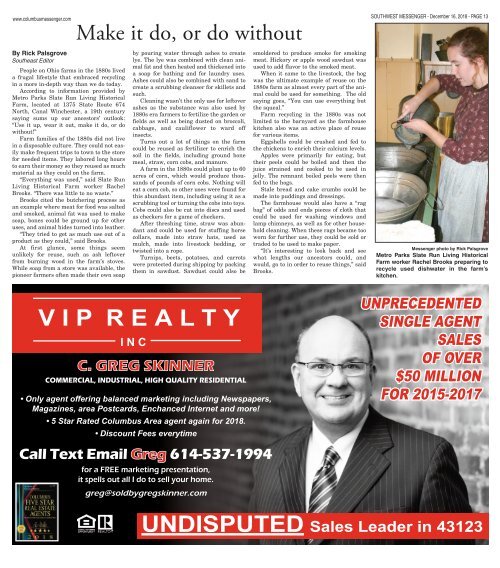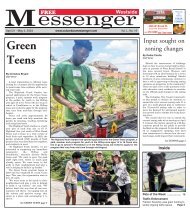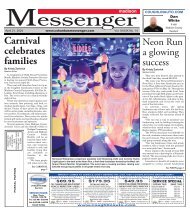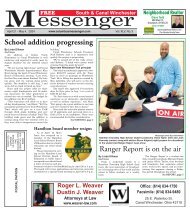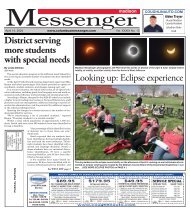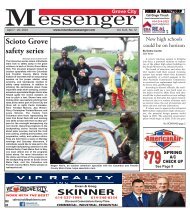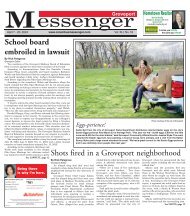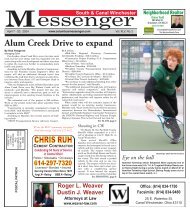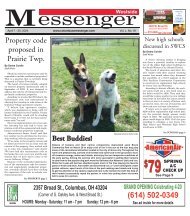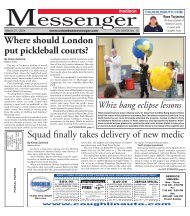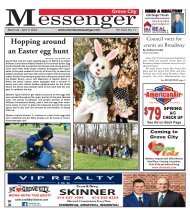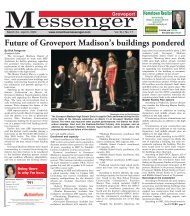You also want an ePaper? Increase the reach of your titles
YUMPU automatically turns print PDFs into web optimized ePapers that Google loves.
www.columbusmessenger.com<br />
By Rick Palsgrove<br />
Southeast Editor<br />
People on Ohio farms in the 1880s lived<br />
a frugal lifestyle that embraced recycling<br />
in a more in-depth way than we do today.<br />
According to information provided by<br />
Metro Parks Slate Run Living Historical<br />
Farm, located at 1375 State Route 674<br />
North, Canal Winchester, a 19th century<br />
saying sums up our ancestors’ outlook:<br />
“Use it up, wear it out, make it do, or do<br />
without!”<br />
Farm families of the 1880s did not live<br />
in a disposable culture. They could not easily<br />
make frequent trips to town to the store<br />
for needed items. They labored long hours<br />
to earn their money so they reused as much<br />
material as they could on the farm.<br />
“Everything was used,” said Slate Run<br />
Living Historical Farm worker Rachel<br />
Brooks. “There was little to no waste.”<br />
Brooks cited the butchering process as<br />
an example where meat for food was salted<br />
and smoked, animal fat was used to make<br />
soap, bones could be ground up for other<br />
uses, and animal hides turned into leather.<br />
“They tried to get as much use out of a<br />
product as they could,” said Brooks.<br />
At first glance, some things seem<br />
unlikely for reuse, such as ash leftover<br />
from burning wood in the farm’s stoves.<br />
While soap from a store was available, the<br />
pioneer farmers often made their own soap<br />
Make it do, or do without<br />
by pouring water through ashes to create<br />
lye. The lye was combined with clean animal<br />
fat and then heated and thickened into<br />
a soap for bathing and for laundry uses.<br />
Ashes could also be combined with sand to<br />
create a scrubbing cleanser for skillets and<br />
such.<br />
Cleaning wasn’t the only use for leftover<br />
ashes as the substance was also used by<br />
1880s era farmers to fertilize the garden or<br />
fields as well as being dusted on broccoli,<br />
cabbage, and cauliflower to ward off<br />
insects.<br />
Turns out a lot of things on the farm<br />
could be reused as fertilizer to enrich the<br />
soil in the fields, including ground bone<br />
meal, straw, corn cobs, and manure.<br />
A farm in the 1880s could plant up to 60<br />
acres of corn, which would produce thousands<br />
of pounds of corn cobs. Nothing will<br />
eat a corn cob, so other uses were found for<br />
this abundant item, including using it as a<br />
scrubbing tool or turning the cobs into toys.<br />
Cobs could also be cut into discs and used<br />
as checkers for a game of checkers.<br />
After threshing time, straw was abundant<br />
and could be used for stuffing horse<br />
collars, made into straw hats, used as<br />
mulch, made into livestock bedding, or<br />
twisted into a rope.<br />
Turnips, beets, potatoes, and carrots<br />
were protected during shipping by packing<br />
them in sawdust. Sawdust could also be<br />
smoldered to produce smoke for smoking<br />
meat. Hickory or apple wood sawdust was<br />
used to add flavor to the smoked meat.<br />
When it came to the livestock, the hog<br />
was the ultimate example of reuse on the<br />
1880s farm as almost every part of the animal<br />
could be used for something. The old<br />
saying goes, “You can use everything but<br />
the squeal.”<br />
Farm recycling in the 1880s was not<br />
limited to the barnyard as the farmhouse<br />
kitchen also was an active place of reuse<br />
for various items.<br />
Eggshells could be crushed and fed to<br />
the chickens to enrich their calcium levels.<br />
Apples were primarily for eating, but<br />
their peels could be boiled and then the<br />
juice strained and cooked to be used in<br />
jelly. The remnant boiled peels were then<br />
fed to the hogs.<br />
Stale bread and cake crumbs could be<br />
made into puddings and dressings.<br />
The farmhouse would also have a “rag<br />
bag” of odds and ends pieces of cloth that<br />
could be used for washing windows and<br />
lamp chimneys, as well as for other household<br />
cleaning. When these rags became too<br />
worn for further use, they could be sold or<br />
traded to be used to make paper.<br />
“It’s interesting to look back and see<br />
what lengths our ancestors could, and<br />
would, go to in order to reuse things,” said<br />
Brooks.<br />
SOUTHWEST MESSENGER - <strong>December</strong> 16, <strong>2018</strong> - PAGE 13<br />
<strong>Messenger</strong> photo by Rick Palsgrove<br />
Metro Parks Slate Run Living Historical<br />
Farm worker Rachel Brooks preparing to<br />
recycle used dishwater in the farm’s<br />
kitchen.<br />
V I P R E A L T Y<br />
I N C<br />
C. GREG SKINNER<br />
COMMERCIAL, INDUSTRIAL, HIGH QUALITY RESIDENTIAL<br />
• Only agent offering balanced marketing including Newspapers,<br />
Magazines, area Postcards, Enchanced Internet and more!<br />
• 5 Star Rated Columbus Area agent again for <strong>2018</strong>.<br />
• Discount Fees everytime<br />
Call Text Email Greg 614-537-1994<br />
for a FREE marketing presentation,<br />
it spells out all I do to sell your home.<br />
greg@soldbygregskinner.com<br />
UNPRECEDENTED<br />
SINGLE AGENT<br />
SALES<br />
OF OVER<br />
$50 MILLION<br />
FOR 2015-2017<br />
UNDISPUTED Sales Leader in 43123


